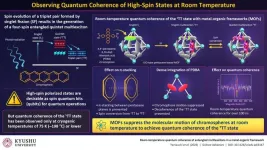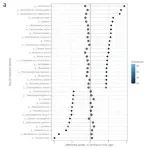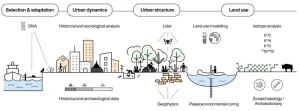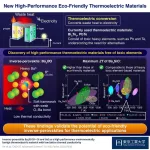(Press-News.org)
Fukuoka, Japan—In a study published in Science Advances, a group of researchers led by Associate Professor Nobuhiro Yanai from Kyushu University's Faculty of Engineering, in collaboration with Associate Professor Kiyoshi Miyata from Kyushu University and Professor Yasuhiro Kobori of Kobe University, reports that they have achieved quantum coherence at room temperature: the ability of a quantum system to maintain a well-defined state over time without getting affected by surrounding disturbances
This breakthrough was made possible by embedding a chromophore, a dye molecule that absorbs light and emits color, in a metal-organic framework, or MOF, a nanoporous crystalline material composed of metal ions and organic ligands.
Their findings mark a crucial advancement for quantum computing and sensing technologies. While quantum computing is positioned as the next major advancement of computing technology, quantum sensing is a sensing technology that utilizes the quantum mechanical properties of qubits (quantum analogs of bits in classical computing that can exist in a superposition of 0 and 1).
Various systems can be employed to implement qubits, with one approach being the utilization of intrinsic spin—a quantum property related to a particle’s magnetic moment—of an electron. Electrons have two spin states: spin up and spin down. Qubits based on spin can exist in a combination of these states and can be “entangled,” allowing the state of one qubit to be inferred from another.
By leveraging the extremely sensitive nature of a quantum entangled state to environmental noise, quantum sensing technology is expected to enable sensing with higher resolution and sensitivity compared to traditional techniques. However, so far, it has been challenging to entangle four electrons and make them respond to external molecules, that is, achieve quantum sensing using a nanoporous MOF.
Notably, chromophores can be used to excite electrons with desirable electron spins at room temperatures through a process called singlet fission. However, at room temperature causes the quantum information stored in qubits to lose quantum superposition and entanglement. As a result, it is usually only possible to achieve quantum coherence at liquid nitrogen level temperatures.
To suppress the molecular motion and achieve room-temperature quantum coherence, the researchers introduced a chromophore based on pentacene (polycyclic aromatic hydrocarbon consisting of five linearly fused benzene rings) in a UiO-type MOF. “The MOF in this work is a unique system that can densely accumulate chromophores. Additionally, the nanopores inside the crystal enable the chromophore to rotate, but at a very restrained angle,” says Yanai.
The MOF structure facilitated enough motion in the pentacene units to allow the electrons to transition from the triplet state to a quintet state, while also sufficiently suppressing motion at room temperature to maintain quantum coherence of the quintet multiexciton state. Upon photoexciting electrons with microwave pulses, the researchers could observe the quantum coherence of the state for over 100 nanoseconds at room temperature. “This is the first room-temperature quantum coherence of entangled quintets,” remarks an excited Kobori.
While the coherence was observed only for nanoseconds, the findings will pave the way for designing materials for the generation of multiple qubits at room temperatures. “It will be possible to generate quintet multiexciton state qubits more efficiently in the future by searching for guest molecules that can induce more such suppressed motions and by developing suitable MOF structures,” speculates Yanai. “This can open doors to room-temperature molecular quantum computing based on multiple quantum gate control and quantum sensing of various target compounds.”
###
For more information about this research, see "Room-temperature quantum coherence of entangled multiexcitons in a metal-organic framework," Akio Yamauchi, Kentaro Tanaka, Masaaki Fuki, Saiya Fujiwara, Nobuo Kimizuka, Tomohiro Ryu, Masaki Saigo, Ken Onda, Ryota Kusumoto, Nami Ueno, Harumi Sato, Yasuhiro Kobori, Kiyoshi Miyata, and Nobuhiro Yanai, Science Advances, http://doi.org/10.1126/sciadv.adi3147
About Kyushu University
Kyushu University is one of Japan's leading research-oriented institutes of higher education since its founding in 1911. Home to around 19,000 students and 8,000 faculty and staff, Kyushu U's world-class research centers cover a wide range of study areas and research fields, from the humanities and arts to engineering and medical sciences. Its multiple campuses—including one of the largest in Japan—are located around Fukuoka City, a coastal metropolis on the southwestern Japanese island of Kyushu that is frequently ranked among the world's most livable cities and historically known as Japan's gateway to Asia. Through its Vision 2030, Kyushu U will 'Drive Social Change with Integrative Knowledge.' Its synergistic application of knowledge will encompass all of academia and solve issues in society while innovating new systems for a better future.
END
PULLMAN, Wash. -- Researchers have taken the first steps toward finding liquid solvents that may someday help extract critical building materials from lunar and Martian-rock dust, an important piece in making long-term space travel possible.
Using machine learning and computational modeling, Washington State University researchers have found about half a dozen good candidates for solvents that can extract materials on the moon and Mars usable in 3D printing. The work, reported in the Journal of Physical Chemistry B, is led by Soumik Banerjee, associate professor in WSU’s School of Mechanical ...
Where we live and work, our age, and the conditions we grew up in can influence our health and lead to disparities, but these factors can be difficult for clinicians and researchers to capture and address. A new study by investigators from Mass General Brigham demonstrates that large language models (LLMs), a type of generative artificial intelligence (AI), can be trained to automatically extract information on social determinants of health (SDoH) from clinicians’ notes which could augment efforts to identify patients who may benefit from ...
Researchers at the University of California San Diego have developed a neural implant that provides information about activity deep inside the brain while sitting on its surface. The implant is made up of a thin, transparent and flexible polymer strip that is packed with a dense array of graphene electrodes. The technology, tested in transgenic mice, brings the researchers a step closer to building a minimally invasive brain-computer interface (BCI) that provides high-resolution data about deep neural activity by using recordings from the brain surface.
The work was published on Jan. 11 in Nature Nanotechnology.
“We are expanding the spatial ...
Cities play a key role in climate change and biodiversity and are one of the most recognizable features of the Anthropocene. They also accelerate innovation and shape social networks, while perpetuating and intensifying inequalities. Today over half of all humanity lives in cities, a threshold which will rise to nearly 70% by the mid-21st century. Yet despite their importance for the Anthropocene, cities are not a recent phenomenon.
In a new study, an interdisciplinary team of authors from the Max Planck Institute of Geoanthropology ...
Francis Crick Institute press release
Under strict embargo: 10:00hrs GMT 11 January 2024
Peer reviewed
Observational study
People
First prehistoric person with Turner syndrome identified from the Iron Age
Earliest known person with Jacob’s syndrome identified from Early Medieval Period
Individuals with Klinefelter syndrome identified across a range of time periods
New technique developed to measure number of chromosomes in ancient genomes more precisely
Researchers at the Francis Crick Institute, working with University of Oxford, University of York ...
Researchers have linked a decade-long decline in the blood lead levels of American Indian adults to long-term cardiovascular health benefits, including reduced blood pressure levels and a reduction in a marker associated with hypertrophic cardiomyopathy and heart failure. The research team, supported by the National Institutes of Health, found that adults who had the greatest reductions in blood lead levels saw their systolic blood pressure fall by about 7 mm Hg, an amount comparable to the effects of blood pressure-lowering medication. Lead exposure is known to harm the health of children by damaging the brain and nervous system and slowing growth and development. It has also been associated ...
Through the Strong Heart Family Study, National Institutes of Health-supported researchers found that small declines in blood lead levelswere associated with long-term cardiovascular health improvements in American Indian adults. Participants who had the greatest reductions in blood lead levels saw their systolic blood pressure fall by about 7 mm Hg, an amount comparable to the effects of blood pressure-lowering medication.
The findings as reported from researchers at Columbia ...
A multi-national team of scientists (China, USA, New Zealand, Italy, and France) analyze the temperature of the Earth annually. These scientists have found a fever that increases every year. For the past decade, each year has been hotter than the prior year in the ocean. And there are other changes in the ocean that also matter.
The ocean is an important part of the Earth's climate system – it covers 70% of the planet and absorbs about 90% of the heat from global warming. The ocean helps control the atmosphere – a warmer ocean leads to a warmer and moister atmosphere with wilder weather. The ocean also controls ...
In a new study, environmentally benign inverse-perovskites with high energy conversion efficiency have been reported by Tokyo Tech scientists with potential for practical application as thermoelectric materials (TEMs). Addressing the limitations typically faced with TEMs, such as insufficient energy conversion efficiency and environmental toxicity due to heavy elements, the new TEMs provide a suitable alternative to TEMs based on toxic elements with better thermoelectric properties than conventional eco-friendly TEMs.
Thermoelectric materials (TEMs) capable of converting thermal energy to electrical energy and vice versa have become an essential part of our world, which needs ...
Humans learn which behaviors pay off and which don’t from watching others. Based on this, we may draw conclusions about how to act – or eat. In the case of the latter, people may use each other as guides to determine what and how much to eat. This is called social modelling and is one of the most powerful social influences on eating behavior.
In a new study, researchers in the UK investigated whether observing others’ facial expressions while eating raw broccoli influenced young women’s liking and desire to ...









